Podcast: Notes and themes from Zen and the Art of Motorcycle Maintenance by Robert Pirsig
Listen here:
The slides are here.
Note: Images are from DALLE (which notoriously misspells image text). Some notes below are AI-assisted.
- What’s the book about?
- What’s the historical context?
-
Major themes in the book
- Classic versus omantic Mmdes of thought
- Quality
- Our Relationship with Technology
- Doing Your Own Maintenance
- Caring about the Work
- Peace of Mind
- Systems Thinking
- Multiple Paths through a Problem
- Troubleshooting
- Being in-the-scene versus Removed
- The Road Trip
- Effortless Action, Going with the Flow
- Traveling along the Backroads
- Presence in the Moment
- References
What’s the book about?
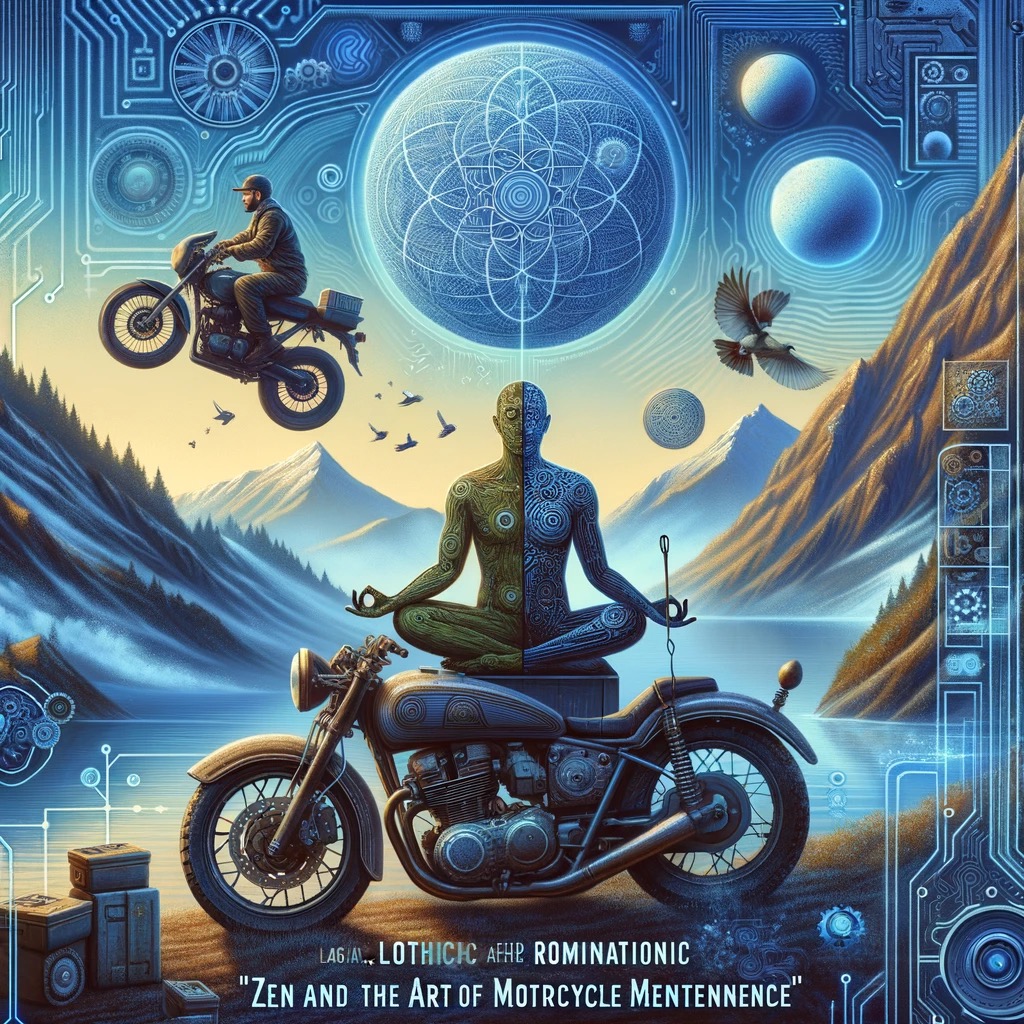
Bridging the duality between technology and art
- In ZAMM, the narrator explores the false dichotomy between rational (logic, analysis) and romantic (intuition, implicit knowledge) perspectives, arguing that they are complementary rather than opposing forces.
- Quality transcends this duality, embodying both the precision and efficiency of technology and the intuition and artistry of romanticism.
- By engaging in motorcycle maintenance, the narrator demonstrates how these two modes of thought can harmoniously coexist.
“The Buddha, the Godhead, resides quite as comfortably in the circuits of a digital computer or the gears of a cycle transmission as he does at the top of a mountain or in the petals of a flower. To think otherwise is to demean the Buddha…which is to demean oneself.” (p. 26)
Healing internal duality
- The narrator’s journey also involves reconciling his past self (troubled with mental illness, enough to undergo electro-shock therapy) with his present identity. He experiences echoes of his former self as he tries to understand who he was and who he is now.
- He also struggles to connect with his son Chris, riding on the back of his motorcycle and potentially showing early signs of similar mental illness.
- Through the process of motorcycle maintenance and the road trip, he overcomes the duality between his current and former self, between himself and Chris, between rationality and intuition, and finds social/intellectual harmony.
Question: What stood out to you about the book? Any particular anecdotes or themes?
What’s the historical context?
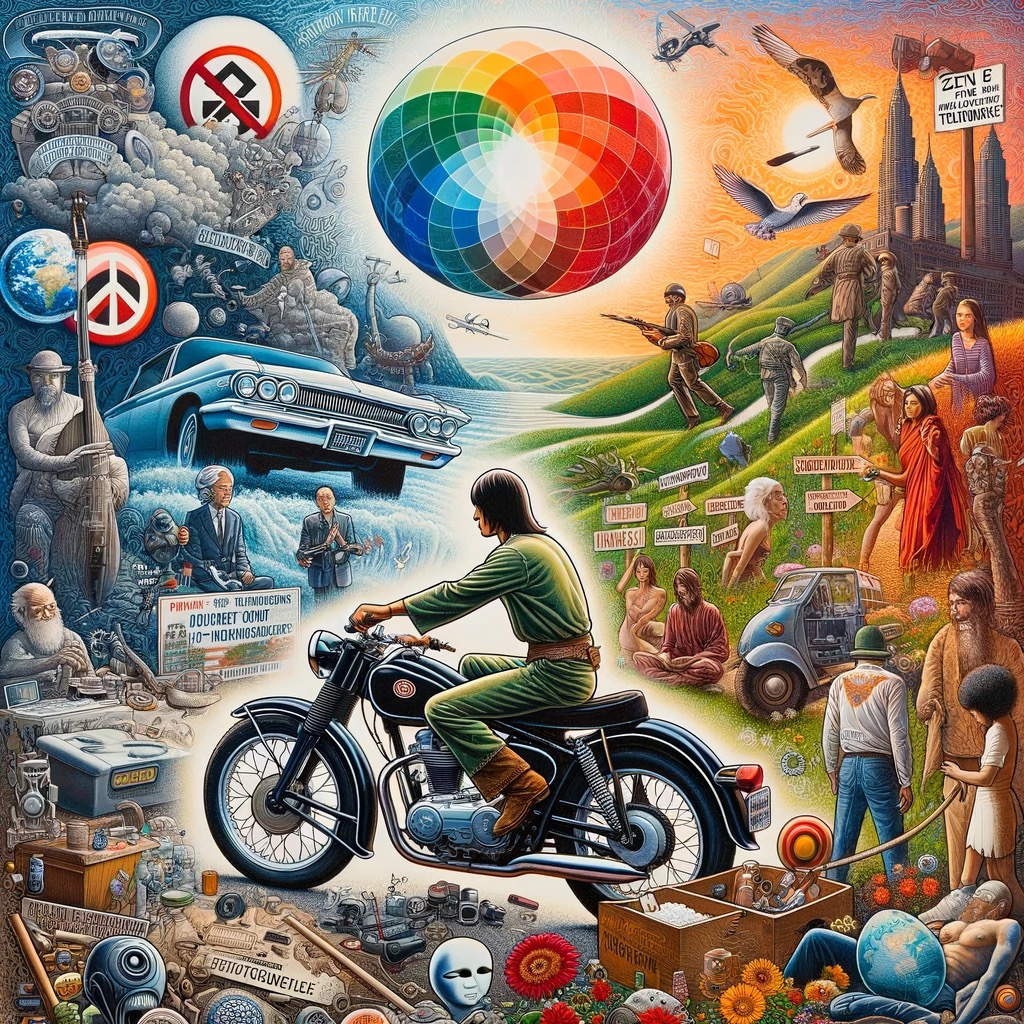
- Counterculture of the 1960s: ZAMM was published in 1974, in the aftermath of the countercultural movement of the 1960s. The counterculture rejected traditional values, including the embrace of technology.
- Hippie culture and technology: Hippies associated technology with the Vietnam War, government surveillance, and environmental degradation.
- Post-countercultural movement: ZAMM emerged during a period of transition, where the countercultural impulses were fading and a new perspective was emerging.
- Reconciliation with technology: Pirsig’s book sought to reconcile the anti-technology sentiments of the counterculture with a more positive and empowering view of technology.
- Humanistic technology: ZAMM argued that technology could be a tool for human connection, creativity, and self-expression.
- Emphasis on individualism and self-reliance: The book also reflected the post-countercultural emphasis on individualism and self-reliance. The narrator’s emphasis on motorcycle maintenance as a personal and transformative experience exemplifies this idea.
- Zen Buddhism: Pirsig was influenced by Zen Buddhism, which emphasizes the importance of mindfulness, intuition, and interconnectedness. The narrator seeks to heal the ugly relationship with technology by showing that Buddha is in the machine.
Question: Were cultural conditions just right for the book to take off (as Pirsig says in the postscript), making it dated to the time? Or do we have a similar cultural context now?
Major themes in the book
Classic versus omantic Mmdes of thought
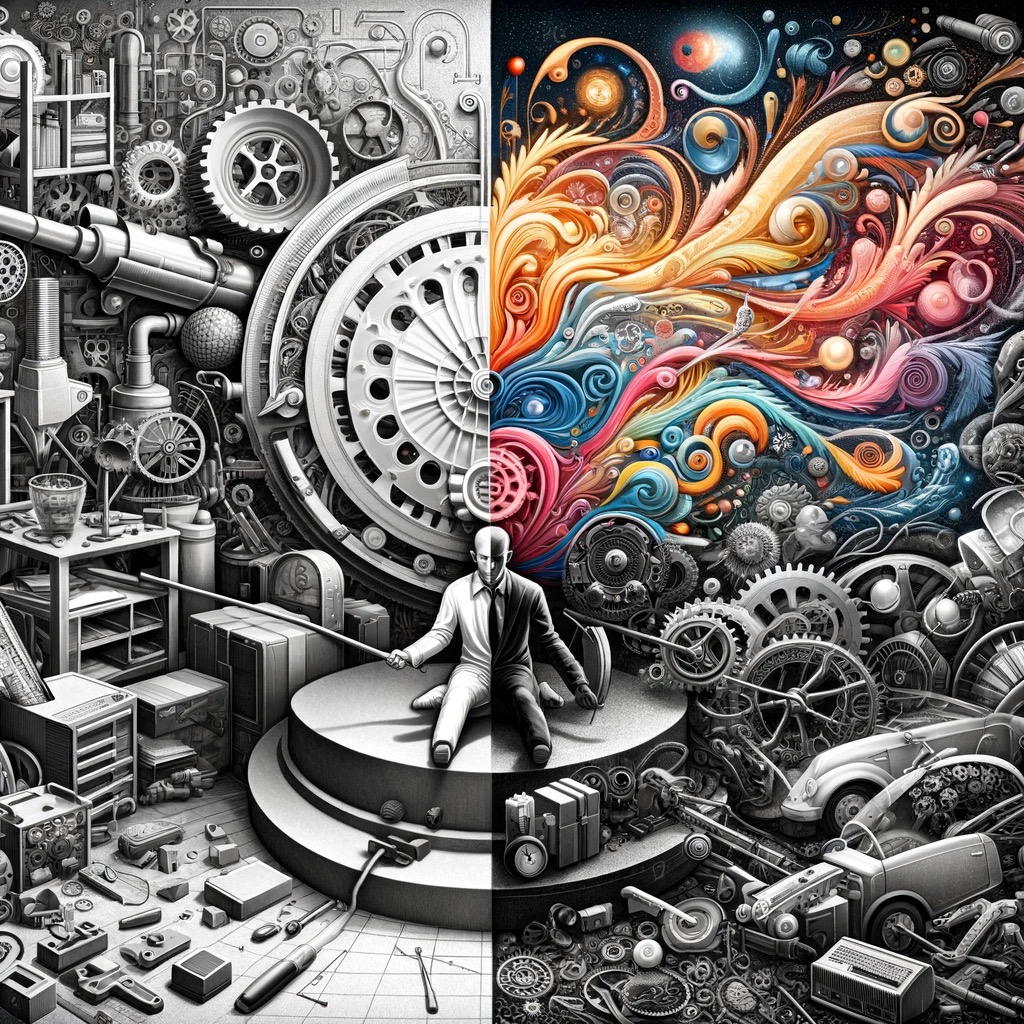
“A classical understanding sees the world primarily as underlying form itself. A romantic understanding sees it primarily in terms of immediate appearance.” (p. 72-74)
“To a romantic this classic mode often appears dull, awkward and ugly, like mechanical maintenance itself. Everything is in terms of pieces and parts and components and relationships. Nothing is figured out until it’s run through the computer a dozen times. Everything’s got to be measured and proved. Oppressive. Heavy. Endlessly grey. The death force. Within the classic mode, however, the romantic has some appearances of his own. Frivolous, irrational, erratic, untrustworthy, interested primarily in pleasure-seeking. Shallow. Of no substance. Often a parasite who cannot or will not carry his own weight. A real drag on society. By now these battle lines should sound a little familiar.” (p. 72-74)
“To put it in more concrete terms: If you want to build a factory, or fix a motorcycle, or set a nation right without getting stuck, then classical, structured, dualistic subject-object knowledge, although necessary, isn’t enough. You have to have some feeling for the quality of the work. You have to have a sense of what’s good. That is what carries you forward. This sense isn’t just something you’re born with, although you are born with it. It’s also something you can develop. It’s not just “intuition,” not just unexplainable “skill” or “talent.” It’s the direct result of contact with basic reality, Quality, which dualistic reason has in the past tended to conceal.” (p. 284)
Question: In your work, how do you draw upon both rational and romantic/intuitive modes of understanding? Do we over-index on the rational?
Quality
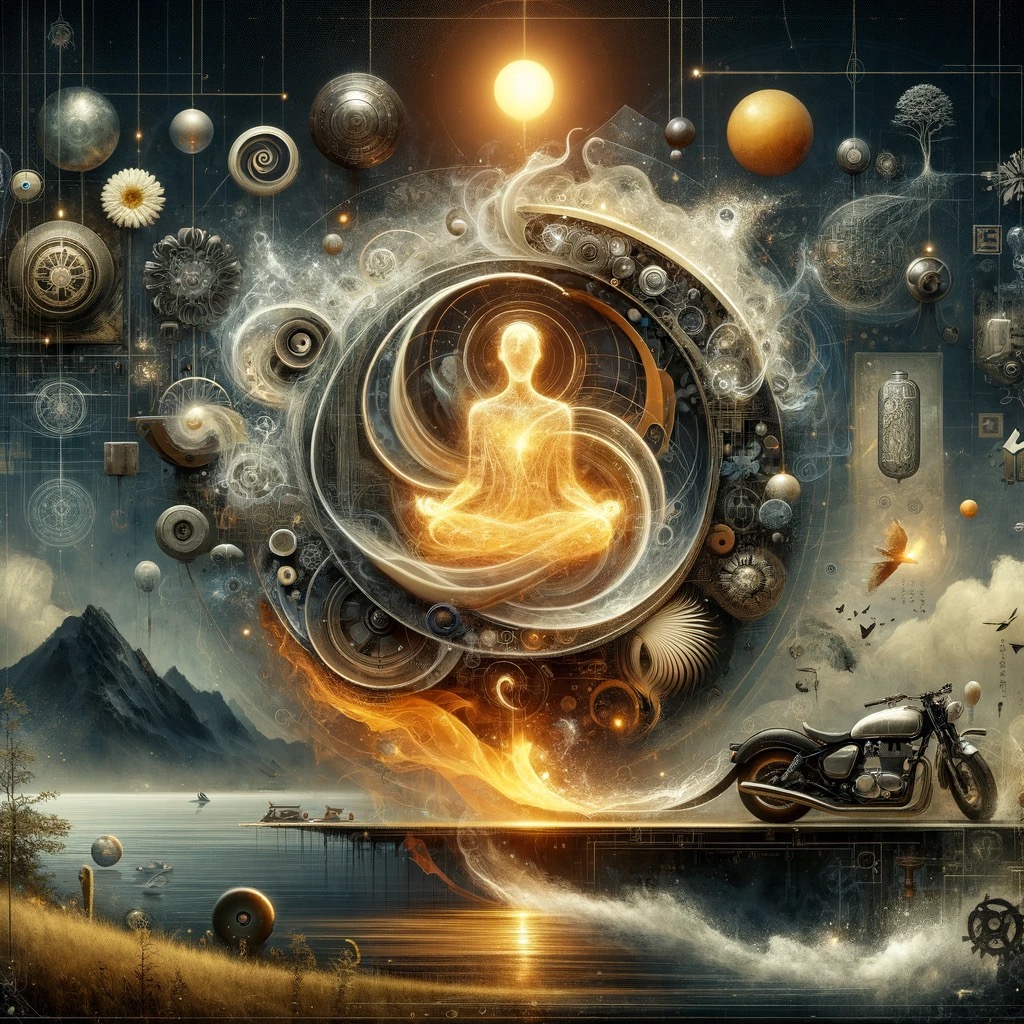
“Quality—you know what it is, yet you don’t know what it is. But that’s self-contradictory. But some things are better than others, that is, they have more quality.” (p. 184)
“I think there is such a thing as Quality, but that as soon as you try to define it, something goes haywire. You can’t do it.” (p. 205-06)
Question: How do you know if your work/product exhibits the Quality aspects the narrator talks about? Does Quality describe products that “just work” or which “delight”?
Our Relationship with Technology
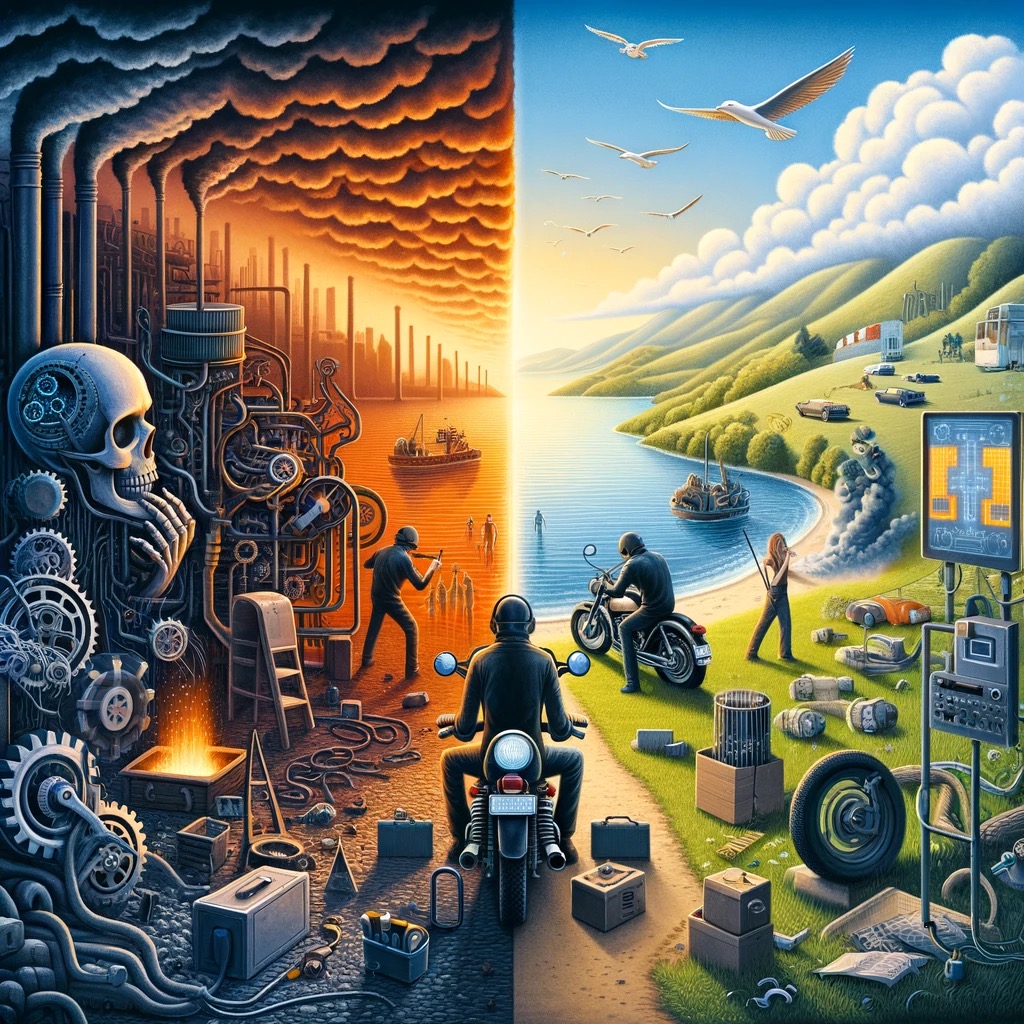
“It’s not the motorcycle maintenance, not the faucet. It’s all of technology they can’t take. And then all sorts of things started tumbling into place and I knew that was it. Sylvia’s irritation at a friend who thought computer programming was ‘creative.’ All their drawings and paintings and photographs without a technological thing in them. Of course she’s not going to get mad at that faucet, I thought. You always suppress momentary anger at something you deeply and permanently hate. Of course John signs off every time the subject of cycle repair comes up, even when it is obvious he is suffering for it. That’s technology. And sure, of course, obviously. It’s so simple when you see it. To get away from technology out into the country in the fresh air and sunshine is why they are on the motorcycle in the first place. For me to bring it back to them just at the point and place where they think they have finally escaped it just frosts both of them, tremendously. That’s why the conversation always breaks and freezes when the subject comes up.” (p. 23)
“But, that doesn’t sound right either. The ‘it’ is a kind of force that gives rise to technology, something undefined, but inhuman, mechanical, lifeless, a blind monster, a death force. Something hideous they are running from but know they can never escape. I’m putting it way too heavily here but in a less emphatic and less defined way this is what it is. Somewhere there are people who understand it and run it but those are technologists, and they speak an inhuman language when describing what they do. It’s all parts and relationships of unheard-of things that never make any sense no matter how often you hear about them. And their things, their monster keeps eating up land and polluting their air and lakes, and there is no way to strike back at it, and hardly any way to escape it.” (p. 24)
Questions:
- What is our relationship with technology — ugly or beautiful? Do we dive in to learn new and unfamiliar things, or resist them?
- Is the narrator’s central goal to fix this ugly relationship with technology? Why is this a topic he cares so much about?
Doing Your Own Maintenance
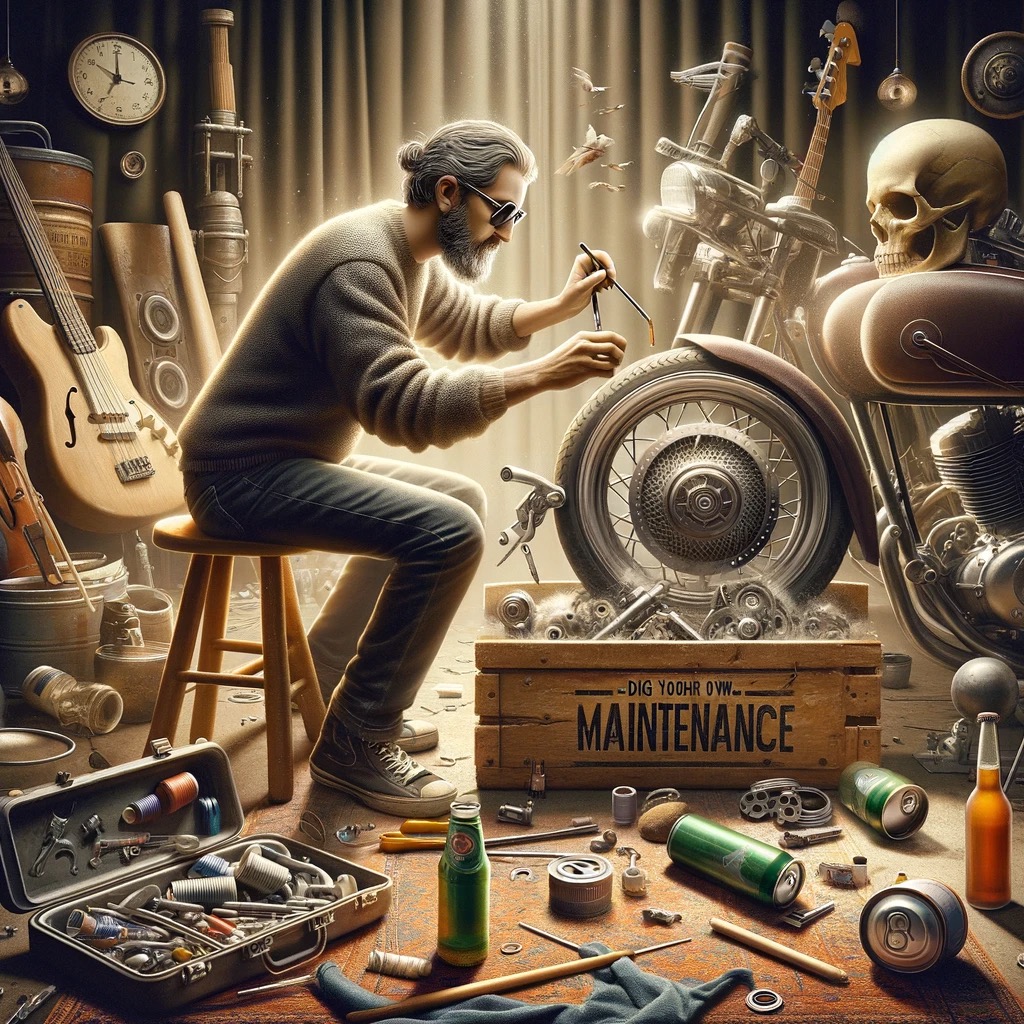
“I guess I forgot to mention John is a musician, a drummer, who works with groups all over town and makes a pretty fair income from it. I suppose he just thinks about everything the way he thinks about drumming…which is to say he doesn’t really think about it at all. He just does it. Is with it. He just responded to fixing his motorcycle with a beer can the way he would respond to someone dragging the beat while he was playing. It just did a big thud with him and that was it. He didn’t want any part of it. ….
“He really does care about technology. It’s just that in this other dimension he gets all screwed up and is rebuffed by it. It just won’t swing for him. He tries to swing it without any rational remeditation and botches it and botches it and botches it and after so many botches gives up and just kind of puts a blanket curse on that whole nuts-and-bolts scene. He will not or cannot believe there is anything in this world for which grooving is not the way to go.” (p. 57)
Question: What do you fix yourself and why? How does it change your relationship with technology?
Caring about the Work

“While at work I was thinking about this same lack of care in the digital computer manuals I was editing. Writing and editing technical manuals is what I do for a living the other eleven months of the year and I knew they were full of errors, ambiguities, omissions and information so completely screwed up you had to read them six times to make any sense out of them. But what struck me for the first time was the agreement of these manuals with the spectator attitude I had seen in the shop. These were spectator manuals. It was built into the format of them. Implicit in every line is the idea that “Here is the machine, isolated in time and in space from everything else in the universe. It has no relationship to you, you have no relationship to it, other than to turn certain switches, maintain voltage levels, check for error conditions—” and so on. That’s it. The mechanics in their attitude toward the machine were really taking no different attitude from the manual’s toward the machine, or from the attitude I had when I brought it in there. We were all spectators. And it occurred to me there is no manual that deals with the real business of motorcycle maintenance, the most important aspect of all. Caring about what you are doing is considered either unimportant or taken for granted.” (p. 34)
Question: How do you learn to care about the work you do? Do you really care about the code or documentation you’re creating? How can you care if you’re in spectator mode?
Peace of Mind
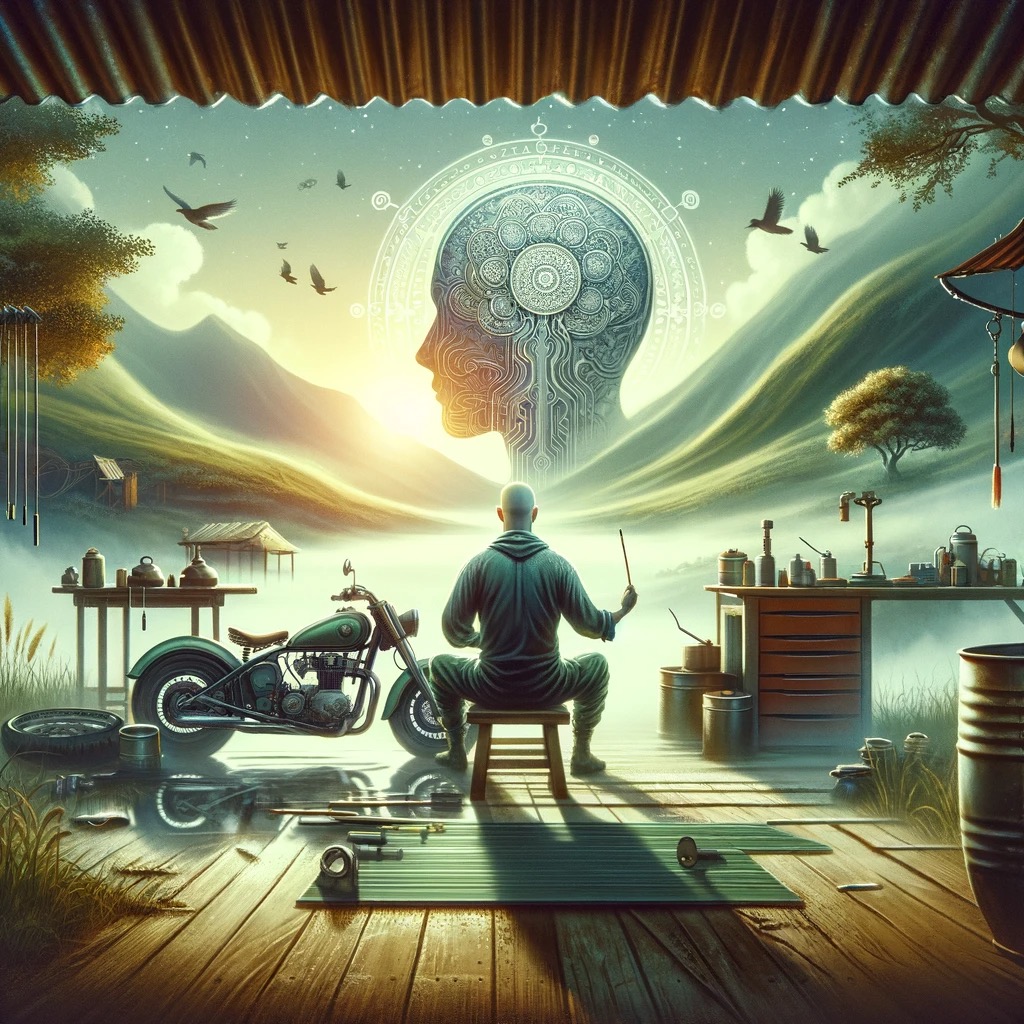
“So the thing to do when working on a motorcycle, as in any other task, is to cultivate the peace of mind which does not separate one’s self from one’s surroundings. When that is done successfully then everything else follows naturally. Peace of mind produces right values, right values produce right thoughts. Right thoughts produce right actions and right actions produce work which will be a material reflection for others to see of the serenity at the center of it all. “ (p. 294-97)
Question: Is this the right mode to achieve to figure things out? Is this patience and peace of mind what experienced technical workers possess?
Systems Thinking
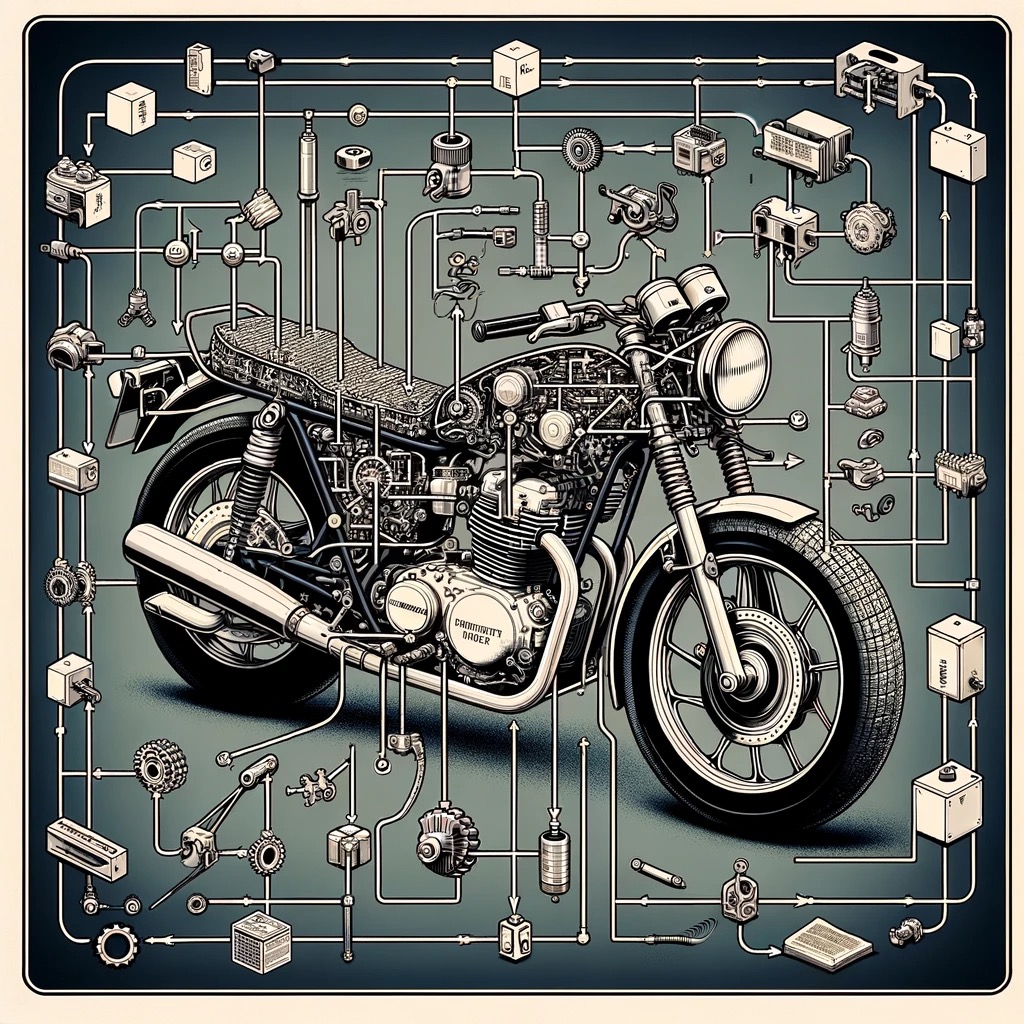
“The box “motorcycle” contains the boxes “components” and “functions.” The box “components” contains the boxes “power assembly” and “running assembly,” and so on. There are many other kinds of structures produced by other operators such as “causes” which produce long chain structures of the form, “A causes B which causes C which causes D,” and so on. A functional description of the motorcycle uses this structure. The operator’s “exists,” “equals,” and “implies” produce still other structures. These structures are normally interrelated in patterns and paths so complex and so enormous no one person can understand more than a small part of them in his lifetime. The overall name of these interrelated structures, the genus of which the hierarchy of containment and structure of causation are just species, is system. The motorcycle is a system. A real system.” (p. 101-102)
Questions:
- Does deeper understanding, the kind that leads to intuitive thinking, require a systems view approach first?
- Should tech docs begin with a high level, or try to always peel back the high level?
Multiple Paths through a Problem
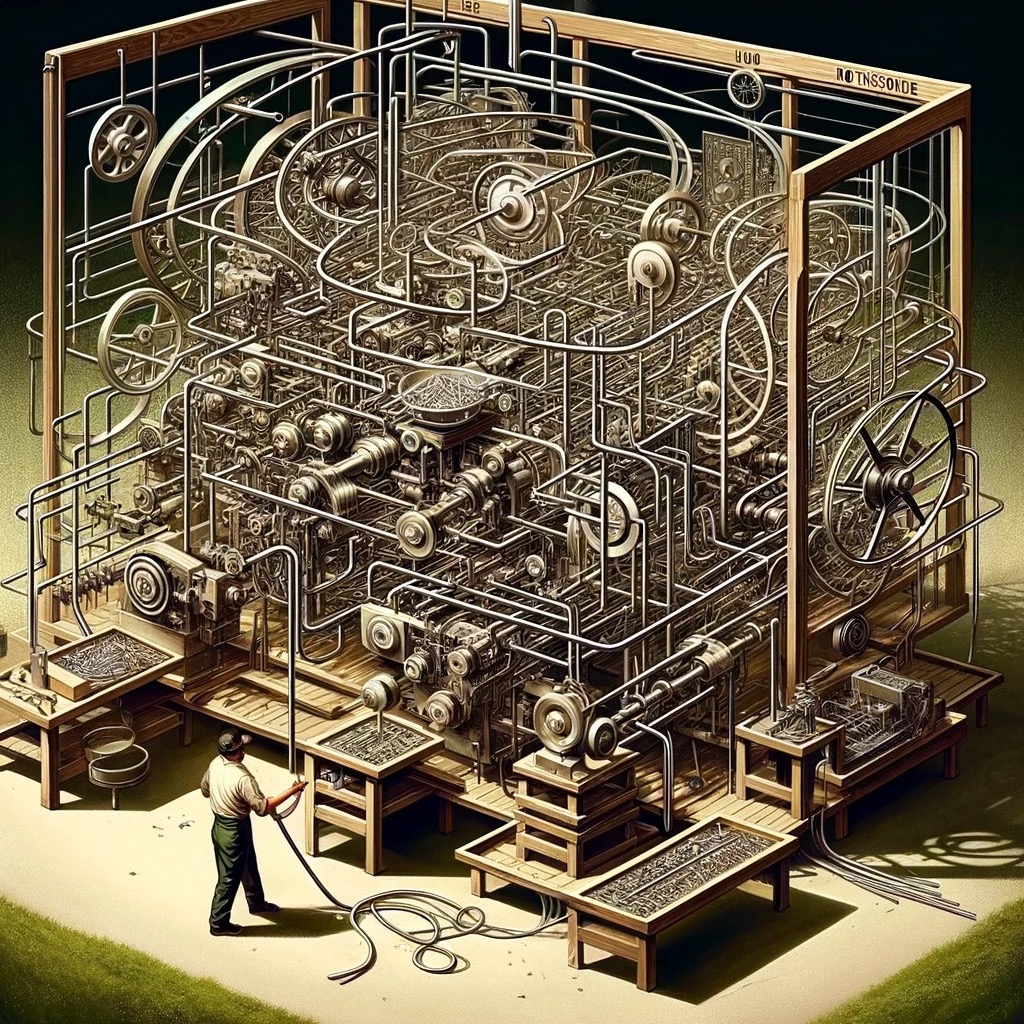
“These rotisserie instructions begin and end exclusively with the machine. But the kind of approach I’m thinking about doesn’t cut it off so narrowly. What’s really angering about instructions of this sort is that they imply there’s only one way to put this rotisserie together…their way. And that presumption wipes out all the creativity. Actually there are hundreds of ways to put the rotisserie together and when they make you follow just one way without showing you the overall problem the instructions become hard to follow in such a way as not to make mistakes. You lose feeling for the work. And not only that, it’s very unlikely that they’ve told you the best way.” (p. 163-67)
Questions:
-
With docs, should we steer away from being prescriptive about a single approach? Do novices need this? Does it do them a disservice in the long run?
-
Do docs introduce a fiction about the right way to do things? one way of assembling something? problems occur if you add notes about multiple options, flexible sequences, etc. ends up requiring notes about tradeoffs, more difficulty to evaluate and ensure accuracy. but leads to shallow user experience.
Troubleshooting
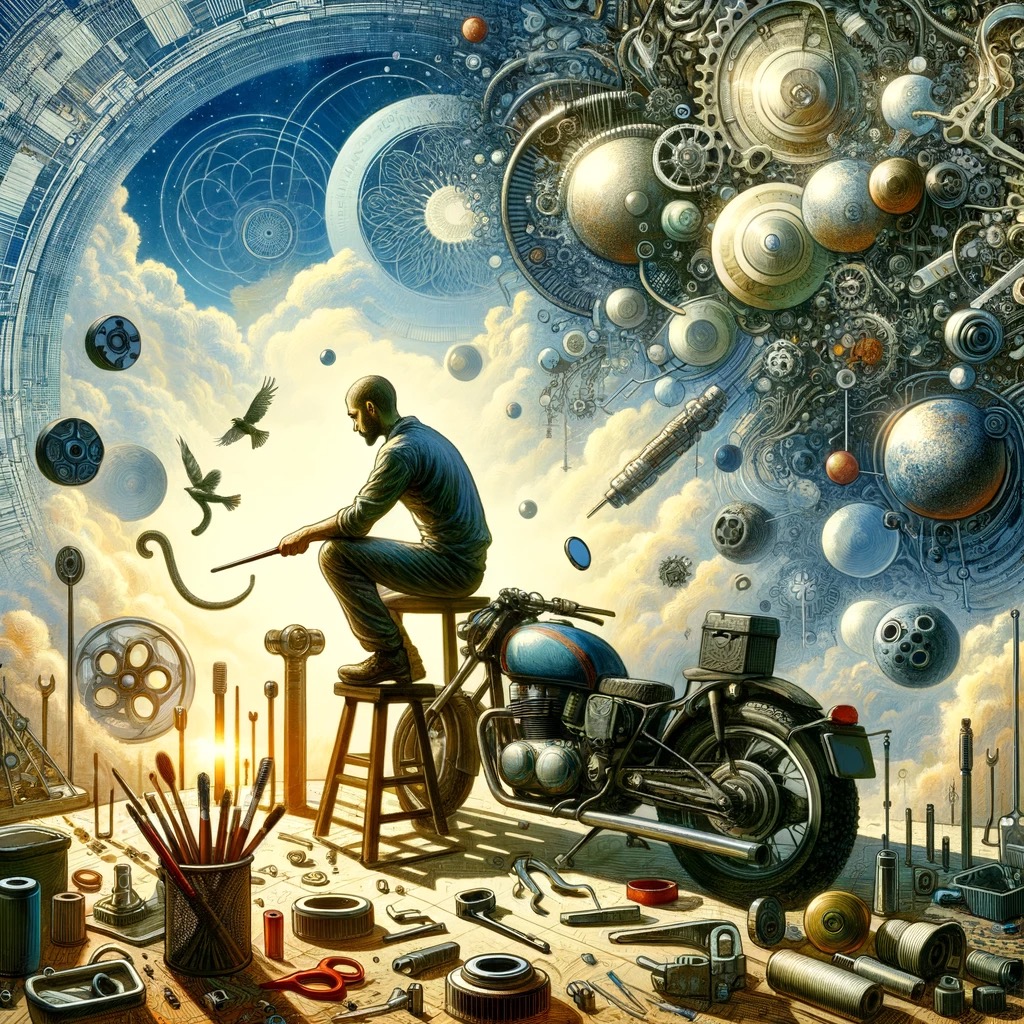
“But now consider the fact that no matter how hard you try to hang on to it, this stuckness is bound to disappear. Your mind will naturally and freely move toward a solution. Unless you are a real master at staying stuck you can’t prevent this. The fear of stuckness is needless because the longer you stay stuck the more you see the Quality…reality that gets you unstuck every time.”
“Let’s consider a reevaluation of the situation in which we assume that the stuckness now occurring, the zero of consciousness, isn’t the worst of all possible situations, but the best possible situation you could be in. After all, it’s exactly this stuckness that Zen Buddhists go to so much trouble to induce; through koans, deep breathing, sitting still and the like. Your mind is empty, you have a “hollow-flexible” attitude of “beginner’s mind.” You’re right at the front end of the train of knowledge, at the track of reality itself. Consider, for a change, that this is a moment to be not feared but cultivated. If your mind is truly, profoundly stuck, then you may be much better off than when it was loaded with ideas.” (p. 285-86)
Question: Which of the gumption traps is the most pervasive? How do you remove all assumptions and learn to see something fresh? Does having the right tools make a huge difference?
Being in-the-scene versus Removed
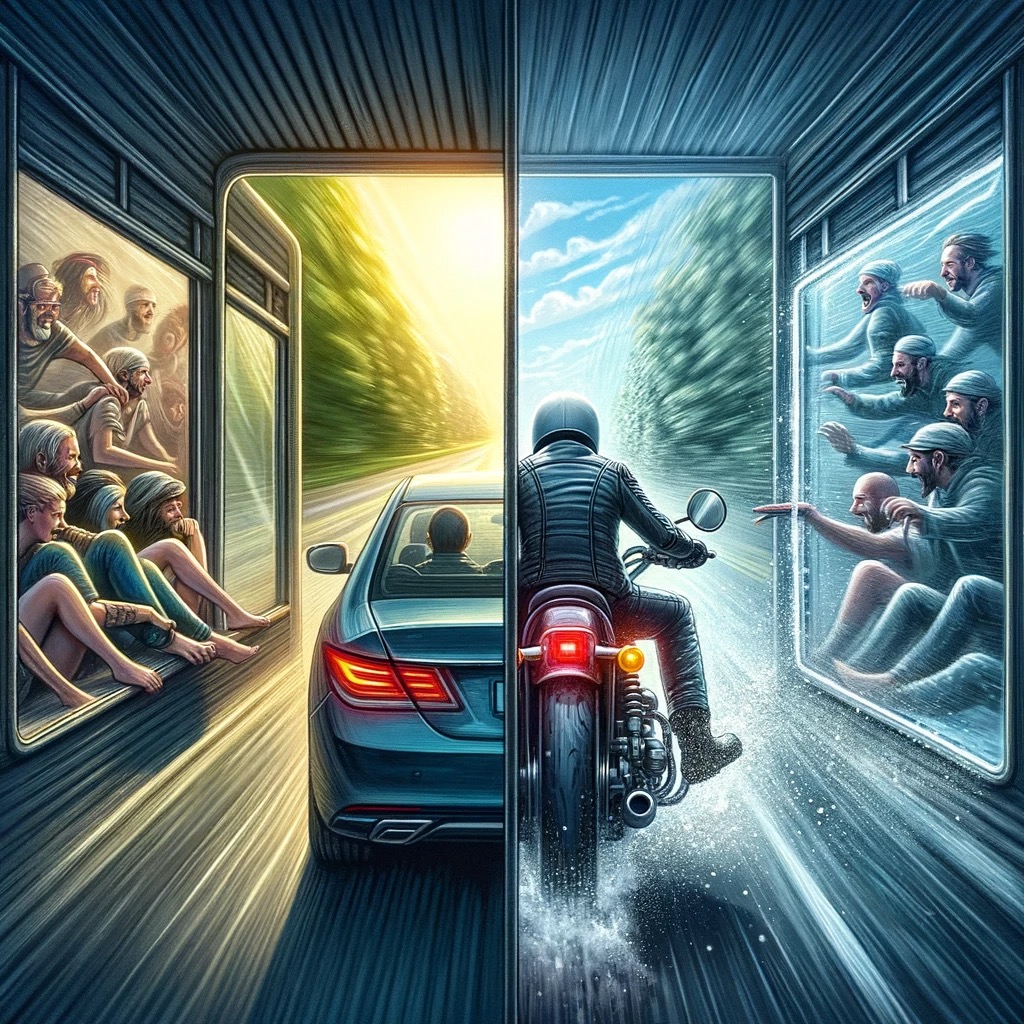
“You see things vacationing on a motorcycle in a way that is completely different from any other. In a car you’re always in a compartment, and because you’re used to it you don’t realize that through that car window everything you see is just more TV. You’re a passive observer and it is all moving by you boringly in a frame. On a cycle the frame is gone. You’re completely in contact with it all. You’re in the scene, not just watching it anymore, and the sense of presence is overwhelming. That concrete whizzing by five inches below your foot is the real thing, the same stuff you walk on, it’s right there, so blurred you can’t focus on it, yet you can put your foot down and touch it anytime, and the whole thing, the whole experience, is never removed from immediate consciousness.” (p. 12)
Question: Is there an analogy to the user experience here? Trading time between intellectual exploration and the user experience?
The Road Trip

“Unless you’re fond of hollering you don’t make great conversations on a running cycle. Instead you spend your time being aware of things and meditating on them. On sights and sounds, on the mood of the weather and things remembered, on the machine and the countryside you’re in, thinking about things at great leisure and length without being hurried and without feeling you’re losing time.”
Question: Is there value in going on a road trip, especially when you have something to sort out in your mind? how many great novels have been written with this journey paradigm? Kerouc’s On the Road? Do we celebrate the car for its ability to offer us freedom on the road like this?
Effortless Action, Going with the Flow
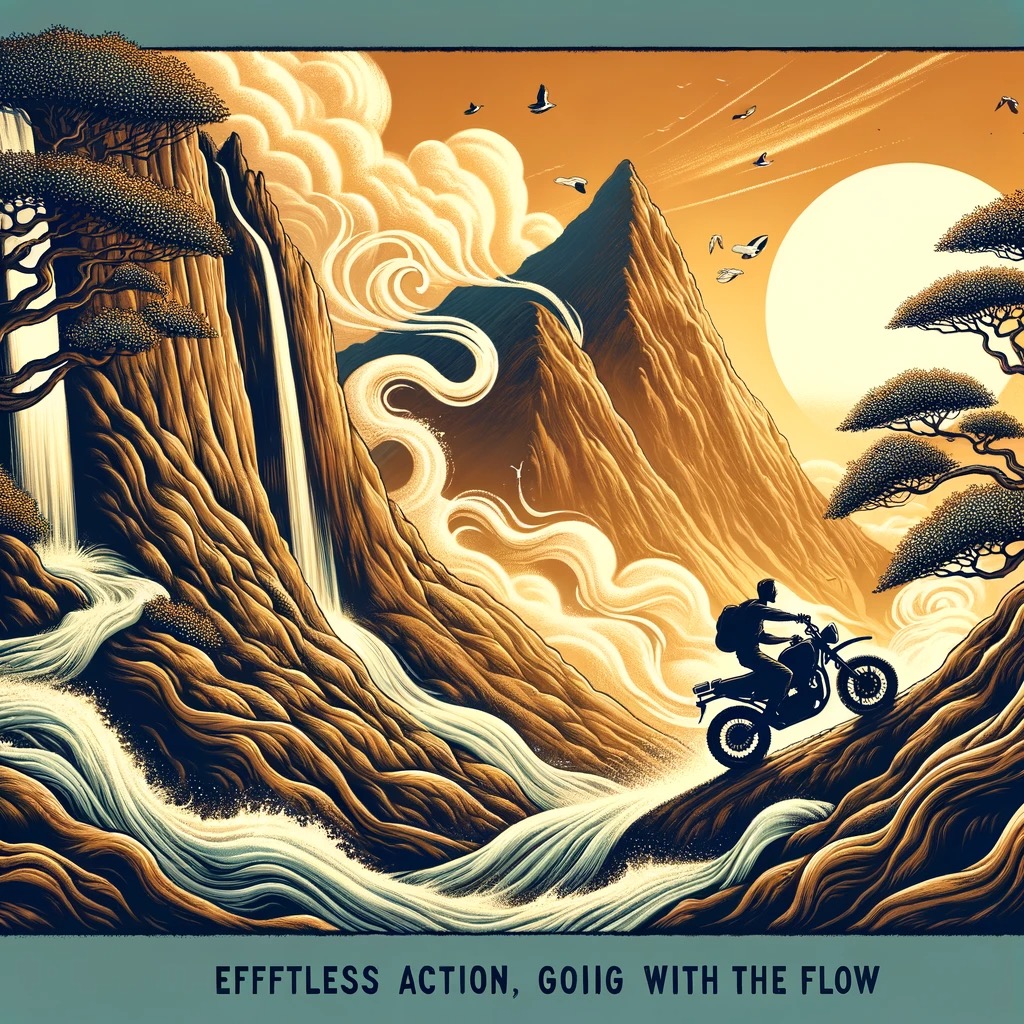
“Mountains should be climbed with as little effort as possible and without desire. The reality of your own nature should determine the speed. If you become restless, speed up. If you become winded, slow down. You climb the mountain in an equilibrium between restlessness and exhaustion. Then, when you’re no longer thinking ahead, each footstep isn’t just a means to an end but a unique event in itself. This leaf has jagged edges. This rock looks loose. From this place the snow is less visible, even though closer. These are things you should notice anyway. To live only for some future goal is shallow. It’s the sides of the mountain which sustain life, not the top. Here’s where things grow. (p. 204)
Question: Is there a kind of wisdom in adopting an approach of effortless action, going with the flow? Taoist parable of falling into river, riding ebbs and flow to safe ground.
Traveling along the Backroads
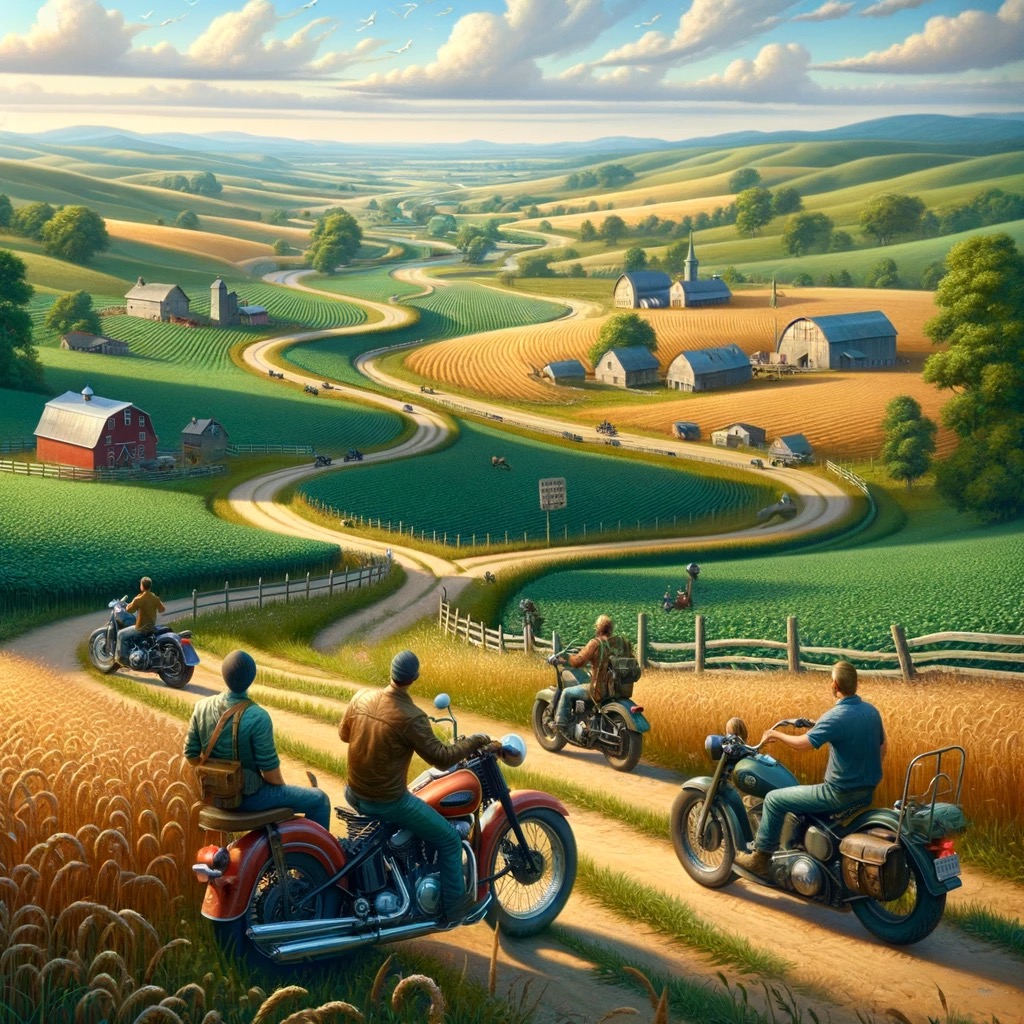
“It was some years ago that my wife and I and our friends first began to catch on to these roads. We took them once in a while for variety or for a shortcut to another main highway, and each time the scenery was grand and we left the road with a feeling of relaxation and enjoyment. We did this time after time before realizing what should have been obvious: these roads are truly different from the main ones. The whole pace of life and personality of the people who live along them are different. They’re not going anywhere. They’re not too busy to be courteous. The hereness and nowness of things is something they know all about. It’s the others, the ones who moved to the cities years ago and their lost offspring, who have all but forgotten it. The discovery was a real find. I’ve wondered why it took us so long to catch on. We saw it and yet we didn’t see it. Or rather we were trained not to see it. Conned, perhaps, into thinking that the real action was metropolitan and all this was just boring hinterland. It was a puzzling thing. The truth knocks on the door and you say, ‘Go away, I’m looking for the truth,’ and so it goes away. Puzzling.” (p. 13)
Presence in the Moment

“I feel happy to be here, and still a little sad to be here too. Sometimes it’s a little better to travel than to arrive.” (p. 119)
Question: Do we much focus on the release rather than the process of writing/coding/building?
References
Page references come from this version of *Zen and the Art of Motorcycle Maintenance (Toronto ; New York :Bantam, 1975), which you can read online here. I actually read this version, published in 2005, but it was easier to find quotes in the PDF.
Here are some scholarly resources providing a tech comm perspective on the book:
-
“Exploring Quality: What Robert Pirsig’s Zen and the Art of Motorcycle Maintenance Can Teach Us About Technical Communication”. IEEE Transactions on Professional Communication.
-
Beck, C. E. (1994). The Most Famous Yet Unusual Technical Writer. Technical Communication, 41(2), 354–357.
This book chapter provides historicaly context for the book:
- Williams, R. J. (2014). *The Buddha in the Machine : Art, technology, and the meeting of east and west Yale University Press.
Here’s a podcast I recorded with Dan Grabski on the book and related themes: Podcast: Tech writing and Zen and the Art of Motorcycle Maintenance, with Dan Grabski.
Music from the podcast is from Simon Fowler’s Small Steps, retrieved from uppbeat.io.
About Tom Johnson

I'm an API technical writer based in the Seattle area. On this blog, I write about topics related to technical writing and communication — such as software documentation, API documentation, AI, information architecture, content strategy, writing processes, plain language, tech comm careers, and more. Check out my API documentation course if you're looking for more info about documenting APIs. Or see my posts on AI and AI course section for more on the latest in AI and tech comm.
If you're a technical writer and want to keep on top of the latest trends in the tech comm, be sure to subscribe to email updates below. You can also learn more about me or contact me. Finally, note that the opinions I express on my blog are my own points of view, not that of my employer.



